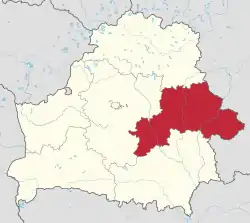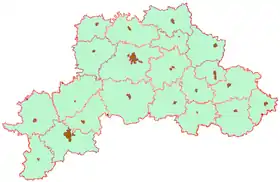Mogilev Region
Mogilev Region, also known as Mogilev Oblast or Mahilyow Voblasts (Belarusian: Магілёўская вобласць, romanized: Mahilioŭskaja voblasć; Russian: Могилёвская область, romanized: Mogilyovskaya oblast), is one of the regions of Belarus. Its administrative center is the city of Mogilev.
Mogilev Region
| |
|---|---|
From the top to bottom-right: Klimavichy District, Mogilev City Hall, Church of Saint Nicholas, Church of the Three Holy Hierarchs, Krychaw District | |
 Flag  Coat of arms | |
 | |
| Country | Belarus |
| Administrative center | Mogilev |
| Largest cities | Mogilev - 365,100 Babruysk - 220,800 Asipovichy - 34,700 |
| Districts | 21 Towns - 14 Urban localities - 12 |
| City districts | 3 |
| Government | |
| • Chairman | Leonid Zayats [1] |
| Area | |
| • Total | 29,079.01 km2 (11,227.47 sq mi) |
| Highest elevation | 239 m (784 ft) |
| Lowest elevation | 126 m (413 ft) |
| Population (2023)[2] | |
| • Total | 989,703 |
| • Density | 34/km2 (88/sq mi) |
| Gross Regional Product | |
| • Total | Br 15.2 billion (€5.2 billion) |
| • Per capita | Br 14,900 (€5,100) |
| ISO 3166 code | BY-MA |
| HDI (2018) | 0.796[4] high · 6th |
| Website | mogilev-region |
Important cities within the region include Mogilev, Asipovichy and Babruysk.
History
Both Mogilev and Gomel Regions suffered severely after the Chernobyl nuclear radioactive reactor catastrophe in April 1986.
Geography
Mogilev Region covers a total area of 29,100 square kilometres (11,200 sq mi),[5] about 14% of the national total. The region's greatest extent from north to south is 150 kilometres (93 mi), from east to west – 300 kilometres (190 mi), while the highest point is 239 metres (784 ft) above sea level and the lowest at 126 metres (413 ft) above sea level.
Many rivers flow through Mogilev Region, including the Dnieper (Dniapro), Berezina, Sozh, Druts, Pronia and Ptsich. The oblast also has small lakes, the largest being the Zaozerye Lake with a surface area of 0.58 square kilometres (0.22 sq mi). The Chigirin Reservoir on the Druts River has an area of 21.1 square kilometres (8.1 sq mi).
The extreme eastern point of Belarus is situated within Mogilev Region to the east of the Khotimsk District.[6]
Climate
Mogilev Region has a temperate continental climate. The region has cold winters and warm summers. January's average temperature reaches from −8.2 °C (17.2 °F) in the northeast to −6.5 °C (20.3 °F) in the southwest. July's average temperature reaches from 17.8 °C (64.0 °F) in the northeast to 18.7 °C (65.7 °F) in the southwest. The region's average yearly vegetative period lasts around 183–194 days. The average precipitation is 575–675 millimetres (22.6–26.6 in) a year with approximately 70% falling during the warm season (April–October).
Demographics
With a total population of 1,088,100 (2011),[5] 353,600 inhabitants live in rural areas and 855,000 live in cities or towns. There are 639,300 women and 567,300 men in the region, of which 288,100 are under 18 while 267,300 are elderly people.
Of the major nationalities living in the Mogilev Region, 1,044,000 inhabitants are Belarusians, 132,000 are Russians, 3,500 are Jewish, 2,800 are Poles, 2,110 are Ukrainians, 1,700 are Tatars, 1,300 are Lithuanians, 1,100 are Armenians, and 1,070 are Romani.
.png.webp) Belarusians in the region>95%90–95%85—90%<85%
Belarusians in the region>95%90–95%85—90%<85%.png.webp) Russians in the region>10%8–10%5–8%<5%
Russians in the region>10%8–10%5–8%<5%
Tourism
The number of travel agencies in Mogilev Region has grown from 20 in 2000 to 50 in 2010, 12 of which provide agent services, the others are tour operators.[7][8] Mogilev Region hosts 3-4% of all the organized tourist arrivals to the Republic of Belarus.[9] The most popular cities to visit in the region are Mogilev and Bobruisk.
Administrative subdivisions
Today the region consists of 21 districts (raions), 195 selsovets, 14 towns, 3 city municipalities, and 12 urban-type settlements.
Districts of Mogilev Region

The 21 districts of Mogilev Region are:
- Asipovichy District
- Babruysk District
- Byalynichy District
- Bykhaw District
- Chavusy District
- Cherykaw District
- Drybin District
- Hlusk District
- Horki District
- Kastsyukovichy District
- Khotsimsk District
- Kirawsk District
- Klichaw District
- Klimavichy District
- Krasnapolle District
- Kruhlaye District
- Krychaw District
- Mogilev District
- Mstsislaw District
- Shklow District
- Slawharad District
Cities and towns
Population of cities and towns in Mogilev Region
| English | Belarusian | Russian | Pop. |
|---|---|---|---|
| Mogilev | Магілёў | Могилёв | 365,100 |
| Babruysk | Бабруйск | Бобруйск | 220,800 |
| Asipovichy | Асiповiчы | Осипо́вичи | 34,700 |
| Horki | Горкі | Горки | 34,000 |
| Krychaw | Крычаў | Кричев | 28,200 |
| Bykhaw | Быхаў | Быхов | 17,300 |
| Kastsyukovichy | Касцюковічы | Костюковичи | 16,100 |
| Klimavichy | Клiмавiчы | Климовичи | 16,000 |
| Shklow | Шклоў | Шклов | 15,900 |
| Mstsislaw | Мсьціслаў | Мстиславль | 11,700 |
| Chavusy | Чавусы | Чаусы | 10,800 |
| Cherykaw | Чэрыкаў | Чериков | 8,400 |
| Slawharad | Слаўгарод | Славгород | 8,300 |
| Klichaw | Клічаў | Кличев | 7,500 |
References
- "Могилевский облсовет утвердил в должности председателя облисполкома Леонида Зайца". www.belta.by (in Russian). 2019-04-03. Retrieved 2019-12-06.
- "Численность населения на 1 января 2023 г. и среднегодовая численность населения за 2022 год по Республике Беларусь в разрезе областей, районов, городов, поселков городского типа". belsat.gov.by. Archived from the original on 17 April 2023. Retrieved 17 October 2023.
- "Gross domestic product and gross regional product by regions and Minsk city in 2022".
- "Sub-national HDI - Area Database - Global Data Lab". hdi.globaldatalab.org. Retrieved 2018-09-13.
- "Main Geographic Characteristics of the Republic of Belarus. Territory and population density of Belarus by region as of January 1, 2011". Land of Ancestors. The Scientific and Production State Republican Unitary Enterprise “National Cadastre Agency” of the State Property Committee of the Republic of Belarus. 2011. Archived from the original on 27 September 2013. Retrieved 24 September 2013.
- "Main Geographic Characteristics of the Republic of Belarus". Land of Ancestors. The Scientific and Production State Republican Unitary Enterprise “National Cadastre Agency” of the State Property Committee of the Republic of Belarus. 2011. Archived from the original on 21 September 2013. Retrieved 20 September 2013.
- Ministry of Sports and Tourism of the Republic of Belarus. (2011). "Number of organizations engaged in tourist activities in 2010 in Belarus". Land of Ancestors. National Statistical Committee of the Republic of Belarus. Archived from the original on 13 October 2013. Retrieved 10 October 2013.
- Ministry of Sports and Tourism of the Republic of Belarus. (2011). "Number of organizations engaged in tourist activities in Belarus by region". Land of Ancestors. National Statistical Committee of the Republic of Belarus. Archived from the original on 13 October 2013. Retrieved 10 October 2013.
- "Arrivals of organized tourists to the Republic of Belarus by region". Land of Ancestors. National Statistical Committee of the Republic of Belarus. 2011. Retrieved 10 October 2013.
External links
- (in Russian and English) Mogilev Regional Executive Committee
.jpg.webp)
.jpg.webp)


.jpg.webp)